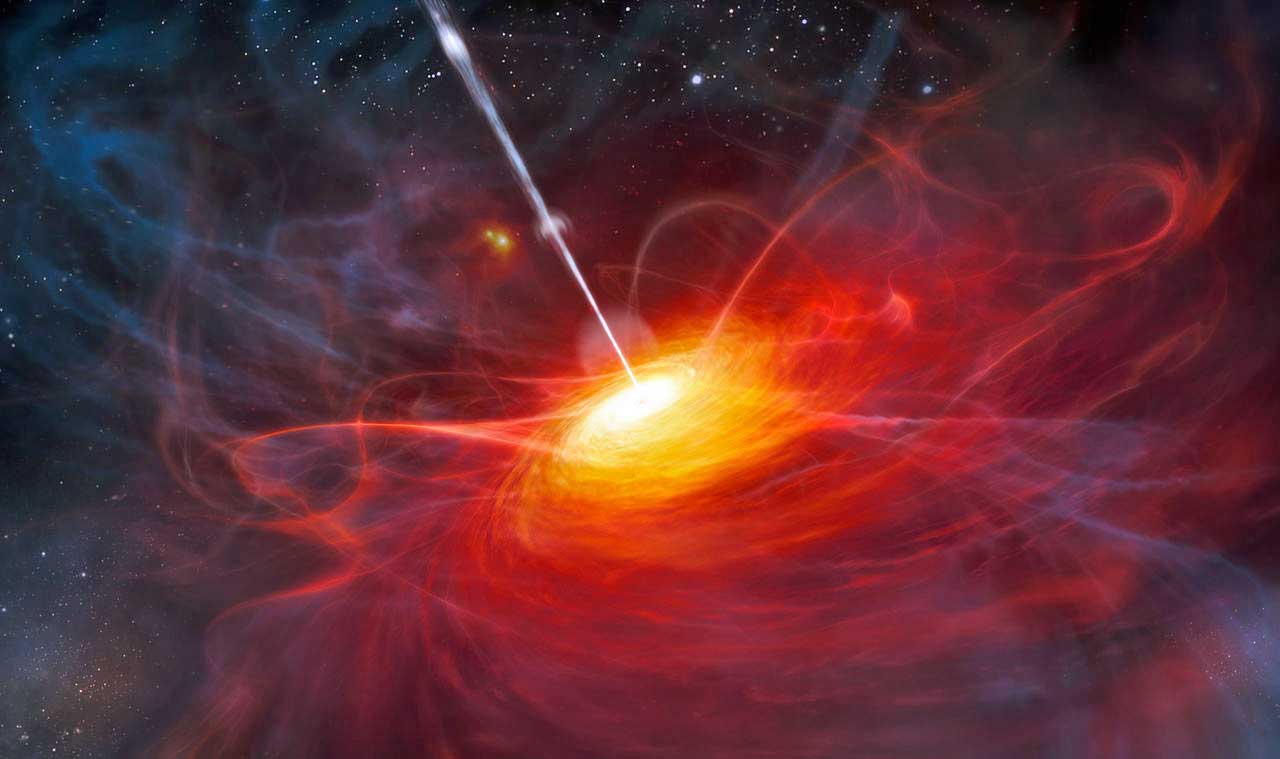|
U.S. astronomers Chen, Hwang, Shen, Liu, Zakamska, Yang and Li (how times have changed) report searching for dual quasars using a novel technique called VODKA.
As in this artist’s sketch, when massive bodies like stars fall into a supermassive black hole (SMBH), an immense amount of energy is released in extremely bright beams of radiation called quasars.
Quasars are the brightest known objects in our universe, hence we can
see them from the farthest distances. They highlight the locations of
SMBHs.

Most
quasars originated during cosmic “high noon” — when the rate of star
formation in our universe peaked. This was from 6 to 12 billion years
ago. Thus, most of the quasars we see are 6 to 12 billion light-years
away.
Almost
all major galaxies have a SMBH in their core. SMBHs are millions to
billions of times the mass of our Sun — the most massive discovered so
far is 60 billion times the mass of our Sun. When they eat voraciously,
we call them active galactic nuclei (AGN).
Astrophysicists
are eager to study SMBHs and particularly how often they merge, which
might help explain how these behemoths grow so massive so quickly. Hence
astronomers strive to find SMBH pairs that are very close to one
another, with “very close” meaning sub-kilo-parsec (within a few
thousand light-years). This allows us to estimate their time-to-merger,
and thereby their merger rate.
Since
most quasars are billions of light-years from us, two quasars only a
few thousand light-years apart will likely appear as just one spot of
light in most telescopes. When faced with such a daunting challenge,
astronomers can be very creative.
As the old saying goes, when life gives you potatoes, make VODKA.
In
this case, astronomers use one problem to solve a different problem.
Each quasar’s intensity tends to be highly variable — it greatly
brightens whenever a star falls into its SMBH, and dims while awaiting
the next morsel. Normally that complicates observations, but this
variation can also be useful.
When
we observe two very close quasars, we sometimes see one spot of light
whose position jitters very slightly as the quasars wax and wane
separately. Detecting that jitter is called varstrometry, and using varstrometry to find off-nucleus and dual sub-kilo-parsec AGN,
is called VODKA. It seems many scientists spend an inordinate amount of
time inventing catchy acronyms (perhaps after consuming vodka).
The
authors demonstrated the effectiveness of VODKA in a pilot study. They
chose a small sample of 81 quasars with unusually large jitter cataloged
by the European Space Agency (ESA) satellite GAIA. GAIA has precisely
measured the positions and properties of more than 1 billion objects in
our Milky Way galaxy and over 700,000 extragalactic bodies.
The
authors observed these 81 quasars with the Hubble Space Telescope, and
found that 38 appeared to be single isolated sources while 43 were
multiple, very close sources. In much of science, and particularly in
astronomy, analyzing the data takes longer and is more difficult than
taking the data. Astronomers need to determine exactly what they
observed.
Here
are four examples that illustrate the diversity of possibilities, with
green X’s marking the GAIA-determined positions. Counting from the left,
picture #1 shows a quasar and an unrelated red star — while the two
bodies are actually far apart, their lines-of-sight differ by only 0.18 arc-sec. Picture #2 shows 3 quasars, 2 seen by GAIA and a third, dimmer quasar below the left green X.

Picture
#3 shows 2 quasars with tidal tails. Picture #4 shows 4 gravitationally
lensed images of the same quasar, 2 seen by GAIA, plus a central
Einstein ring also gravitationally lensed.
The authors demonstrated how to correctly identify dual quasars (picture #2) with spectroscopic analysis and lots of VODKA.
Best Wishes,
Robert

April 1, 2022
Note: Previous newsletters can be found on my website.
|